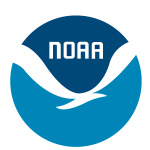- Industry: Government
- Number of terms: 30456
- Number of blossaries: 0
- Company Profile:
NOAA Coral Reef Conservation Program, National Oceanic and Atmospheric Administration, U.S. Department of Commerce
A remote-sensing technique that uses a laser light source to probe the characteristics of a surface target. A laser emission may be directed downward from a low flying aircraft. Information about the target is derived from back-scattered reflectance or fluorescence of the target. Chlorophyll pigments in coral reef organisms (e.g., algae, seagrasses, coral), when excited by shorter (blue or green) wavelength light, emit light at longer (red) wavelengths, i.e., it fluoresces.
Industry:Natural environment
A repository of available information on the taxonomy, biology, ecology, occurrence and utilization of fishes. It holds published information on almost all of the estimated 25,000 existing fish species. The information is arranged in 55 subject tables. It can be accessed through the Internet ( http://www.fishbase.org) or installed on a PC from a CD-ROM. At the heart of fishbase is the authoritative taxonomic fish classification established by W.N. Eschmeyer (California Academy of Science). It ensures that all information is assigned to current scientific names, even if a publication uses an outdated name.
Industry:Natural environment
A research initiative to conduct a taxonomically diversified census of coral reef ecosystems throughout the globe. This international partnership, led by NOAA’s Pacific Islands Fisheries Science Center, the Australian Institute of Marine Science, Scripps Institution of Oceanography, and the Hawai´i Institute of Marine Biology, will expand tropical taxonomic knowledge (with a particular focus on understudied species), increase the exchange of coral reef ecosystem data dispersed throughout the globe, and develop new and innovative technology and sampling strategies, as well as contribute to the coml barcode initiative. Creefs plans to work closely with the NOAA Coral Reef Conservation Program (CRCP) and other organizations on outreach and education, collaboration with other existing coral reef efforts, and collection and unification of data into the Ocean Biogeographic Information Center for research, management, and preservation purposes.
Industry:Natural environment
A scanner system that simultaneously acquires images of the same scene in various wavelength bands.
Industry:Natural environment
A scanning radiometer with six spectral channels centered at 0.443, 0.520, 0.550, 0.670, 0.750 and 11.5 micrometers and selected to allow measurement of ocean color and temperature, suspended sediment and chlorophyll concentrations, and ocean pollutants.
Industry:Natural environment
A scuba diving certifying and instruction agency.
Industry:Natural environment
A series of deepwater coral pinnacles and ridges, 15 to 30 miles off the east coast of Florida, extending from Ft. Pierce to Cape Canaveral. Formed by a single species of coral, the Ivory Tree Coral, Oculina varicosa, they form pinnacles of up to 100 feet tall, growing below the Gulf Stream at depths of approximately 70 to 100 meters. This is a slow-growing, branching coral often associated with high biodiversity because they provide ideal habitats and spawning sites for numerous species of fishes and invertebrates.
Industry:Natural environment
A broad, collaborative program to provide increased access to data and information on the nation's biological resources. The NBII links diverse, high-quality biological databases, information products, and analytical toolsmaintained by NBII partners and other contributors in government agencies, academic institutions, non-government organizations, and private industry.
Industry:Natural environment
A broad-band, four or five channel (depending on the model) scanner, sensing in the visible, near-infrared, and thermal infrared portions of the electromagnetic spectrum. This sensor is carried on NOAA's Polar Orbiting Environmental Satellites (POES). AVHRR is used for studying and monitoring vegetation conditions. Applications include agricultural assessment, land cover mapping, producing image maps of large areas and tracking regional and continental snow cover. AVHRR data are also used to retrieve various geophysical parameters such as sea surface temperatures (SST) and energy budget data.
Industry:Natural environment
